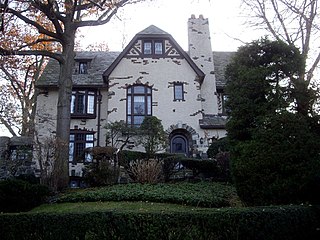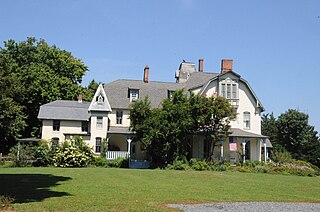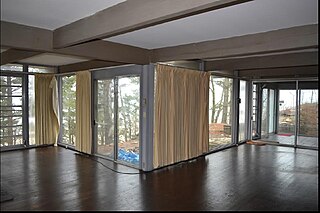
Ralph Johnson Bunche House, the last home of American diplomat Ralph Bunche (1903-1971), is a National Historic Landmark in New York City. It is a single-family home built in 1927 in the neo-Tudor style, and is located at 115-24 Grosvenor Road, Kew Gardens, Queens. It is named after Ralph Bunche, who helped to found the United Nations in 1945. In 1950 he became the first African American and first person of color to win the Nobel Peace Prize, for mediating armistice agreements between Israel and its neighboring countries.

The O. E. Rølvaag House was the home of Ole Edvart Rølvaag (1876–1931), Norwegian-American novelist and professor at St. Olaf College. The home is located at 311 Manitou Street in Northfield, Minnesota, United States. Rølvaag wrote most of his works in this house, which is near St. Olaf College, where he taught.

The Merion Friends Meeting House is an active and historic Quaker meeting house at 615 Montgomery Avenue in Merion Station, Pennsylvania. Completed about 1715, it is the second oldest Friends meeting house in the United States, with distinctively Welsh architectural features that distinguish it from later meeting houses. It is home to the Merion monthly meeting. The meeting house was declared a National Historic Landmark in 1999.

The Lewis House is a historic house at 276 Woburn Street in Reading, Massachusetts. The 2+1⁄2-story wood-frame house was built in the late 1870s by John Lewis, a successful shoe dealer. The house is three bays wide, with a hipped roof with a single gable dormer. The roof has extended eaves with false rafter ends that are actually lengthened modillion blocks; these features give the house a Colonial Revival feel. The corner boards are pilastered, and the front entry is flanked by half-length sidelight windows and topped by a pedimented lintel, above which is a round fanlight window.

Lauretum is a historic home located at Chestertown, Kent County, Maryland, United States. It is a large, three story late Victorian stuccoed frame house built in 1881 for Chestertown lawyer Harrison W. Vickers (1845-1911). It features irregular massing, multiple roof forms, clipped gables, an oriel window, and exposed rafter ends. It was designed by Baltimore architect Edmund G. Lind (1829-1909).

The W. C. Baker House is an airplane bungalow located at 301 E. Commerce in the city of Altus, Oklahoma. The house was built in 1917 for the sister of William Clarence Baker; however, Baker bought the house shortly afterward. Baker owned a local machine shop and cotton gin, and he served on Altus' original city council. The house has a typical airplane bungalow plan with a small second story above a low, multi-component first-floor roof, a design reminiscent of an airplane's cockpit. The house's design also includes many characteristic features of the Craftsman style, including overhanging eaves and exposed rafter tails. The porch features battered columns supporting its roof and decorative stickwork in its gable, both of which are typical Craftsman elements.

The Kellogg House is a historic home located at Cornwall in Orange County, New York. It was built about 1795 and is a 2+1⁄2-story, five-bay, center-hall-plan wood-frame dwelling. It features an overhanging gable roof with exposed rafters.

The Charles Bower House is a historic house located north of Jerome, Idaho, United States. The lava rock house was built by mason H.T. Pugh in 1917. The listing includes a 2.5-acre (1.0 ha) area. In addition to its rock walls, the home features a gable roof with exposed rafters and wide eaves. The original roof was replaced after a 1921 storm. The house was the home of Charles Bower and his family from 1917 until 1922.

The Knight–Mangum House is a historic house located in Provo, Utah, United States. It is listed on the National Register of Historic Places. The mansion was built in the old English Tudor style, completed in 1908. It was built for Mr. W. Lester Mangum and his wife Jennie Knight Mangum. Mrs. Mangum was the daughter of the famous Utah mining man, Jesse Knight. The lot was purchased for $3,500 and the home was built at a cost of about $40,000. The Mangum family was able to afford the home due to the fact that they had sold their shares in Jesse Knight's mine located in Tintic, Utah, for eight dollars a share. They had purchased the shares for only twenty cents a share, so the excess allowed them enough funds to purchase the home. The contractors for the home were the Alexandis Brothers of Provo.

The Dick Callen House is a historic house located 3.25 miles (5.23 km) south of Jerome, Idaho, United States. The lava rock home was built in 1917 by a stonemason named Otis. The home is designed in the bungalow style and features a gable roof with exposed rafters, wide eaves, and multiple purlins.

Stotesbury Club House is a historic clubhouse located at Wyndmoor in Springfield Township, Montgomery County, Pennsylvania. It was built between 1904 and 1908, for Edward T. Stotesbury (1849-1938) as an equestrian center building. An addition was completed in 1927. It is a 1 1/2-story, "L"-shaped frame building in the Arts and Crafts style. It has a gable roof and a shingled gable dormer. The front facade features an open porch supported by three Doric order columns and the rear has a raised flat-stone patio. Stotesbury sold the house in 1924.

Recoleta, also known as Rothery, is a historic home located at Charlottesville, Virginia. It was built in 1940, and is a two- to three-story, "U"-shaped, Spanish Colonial Revival style dwelling. The house is constructed of stuccoed reinforced cinder block and has a red tile gable roof, arched openings, an exterior stair, a balcony, and steel-framed casement windows. The "U" contains a patio enclosed by a loggia with a garden front. Also on the property is a contributing garden enclosed by a cinder block wall built in 1946 that incorporates a fountain wall with a tile roof, circular lantern niches, and a patio. The house was built for University of Virginia music professor Harry Rogers Pratt and his wife, Agnes Edwards Rothery Pratt.

The E. V. Cooke House is a historic house located northeast of Jerome, Idaho. The lava rock house was constructed in 1919 by stonemason H. T. Pugh. The bungalow-style home features a gable roof with exposed rafters, a gabled dormer with bracketed eaves, and a full porch. The home is similar in style to Pugh's E. C. Gleason House, which he built in Jerome the prior year.

The Ed M. Stotlar House is a historic house located at 1304 W. Main St. in Marion, Illinois. The house was built in 1914-15 for Southern Illinois lumber salesman Ed M. Stotlar and his family. Stotlar was also the longtime president of the Marion Library Board and a prominent art and book collector. Architect George William Ashby designed the home in a blend of the American Craftsman and Prairie School styles. The house features connected double-hung windows and a gable roof with overhanging eaves and exposed rafter tails, characteristic features of the Craftsman style. Its Prairie School influences include its art glass windows and horizontal ribbons of brick near the top of the first floor.

The House at 1487 Loma Vista Street is a historic house located at 1487 Loma Vista Street in Pasadena, California. The American Craftsman house was built in 1913 in the city's Pasadena Heights neighborhood. A gable with paired brackets covers the front porch and part of the first story; the gable is supported by three concrete piers topped by decorative lumber uprights. The sides and rear of the house each have gables at both the first and second stories. All of the gables in the house have exaggerated peaks inspired by Asian architecture, wide eaves, and exposed rafter tails. The property includes a similarly designed garage, which also has an exaggerated gable peak and is considered a contributing building.

Erle Stillwell House II is a historic home located at Hendersonville, Henderson County, North Carolina. It was built in 1935, and is a one-story, eclectic French Eclectic brick dwelling with some Tudor Revival style design elements. It has a multi-gable and hip roof and a massive brick chimney at the juncture between the main house and the garage wing. The recessed front entry porch features heavy-timbered arches and curved rafters, with a projecting front gable bay. It was designed and built by locally prominent architect Erle Stillwell, who built the neighboring Erle Stillwell House in 1926.

Dan E. Caison Sr. House is a historic home located at Roseboro, Sampson County, North Carolina. The house was built in 1924, and is a two-story, Bungalow / American Craftsman style frame dwelling. It has a gable roof with exposed projecting rafters and triangular brackets, porte cochere, and a wrap-around porch with an intersecting gable roof. Also on the property are the contributing garage and small maid's house.

The E. Payne Palmer House is a Gordon-Van Tine "Brentwood" model of a catalog kit house, or pre-cut house, that was built in 1925 on Central Avenue in Phoenix, Arizona.

The Dr. John and Gerda Meyer House is an International Style designed home, in an appropriate setting on the ridge of sand dune in the lakeside resort community of Beverly Shores, Indiana. The house has a lower level that opens to the rear (south) side of the dune; the house's main level is located at the top of the dune and overlooks Lake Michigan, which is to its north. A small patio is located on the north side of the house. A staircase that is made of wood connects the patio to the base of the sand dune and Lake Front Drive. A concrete driveway and terraced wood steps connect the south side of the house to Fairwater Drive, at the base of the sand dune.

Alfred W. Greer House is a historic home located at Poplar Bluff, Butler County, Missouri. It was built in 1915, and is a 2+1⁄2-story, rectangular plan, American Craftsman style brick dwelling with a 2+1⁄2-story side wing. It has a gable roof with wide eaves and exposed rafters and features large brick porch piers on the main facade.























